Principles of International Business Report: Starbucks Analysis
VerifiedAdded on 2023/03/20
|8
|1810
|48
Report
AI Summary
This report analyzes Starbucks' international business ventures, specifically focusing on its entry into the Australian market and the subsequent challenges faced. The report examines various modes of market entry, such as franchising, and discusses the advantages and disadvantages associated with each. It delves into the reasons behind Starbucks' struggles in Australia, including cultural differences, consumer preferences, and the company's failure to adapt its business model to the local market. Furthermore, the report explores ethical issues in global business, including employment practices, human rights, and environmental pollution, referencing these issues in the context of Starbucks' operations. The report also examines the impact of child labor in global supply chains and the role of companies like Coles in ensuring ethical sourcing. The analysis is supported by references to relevant academic sources and provides a comprehensive overview of the complexities of international business and corporate social responsibility.
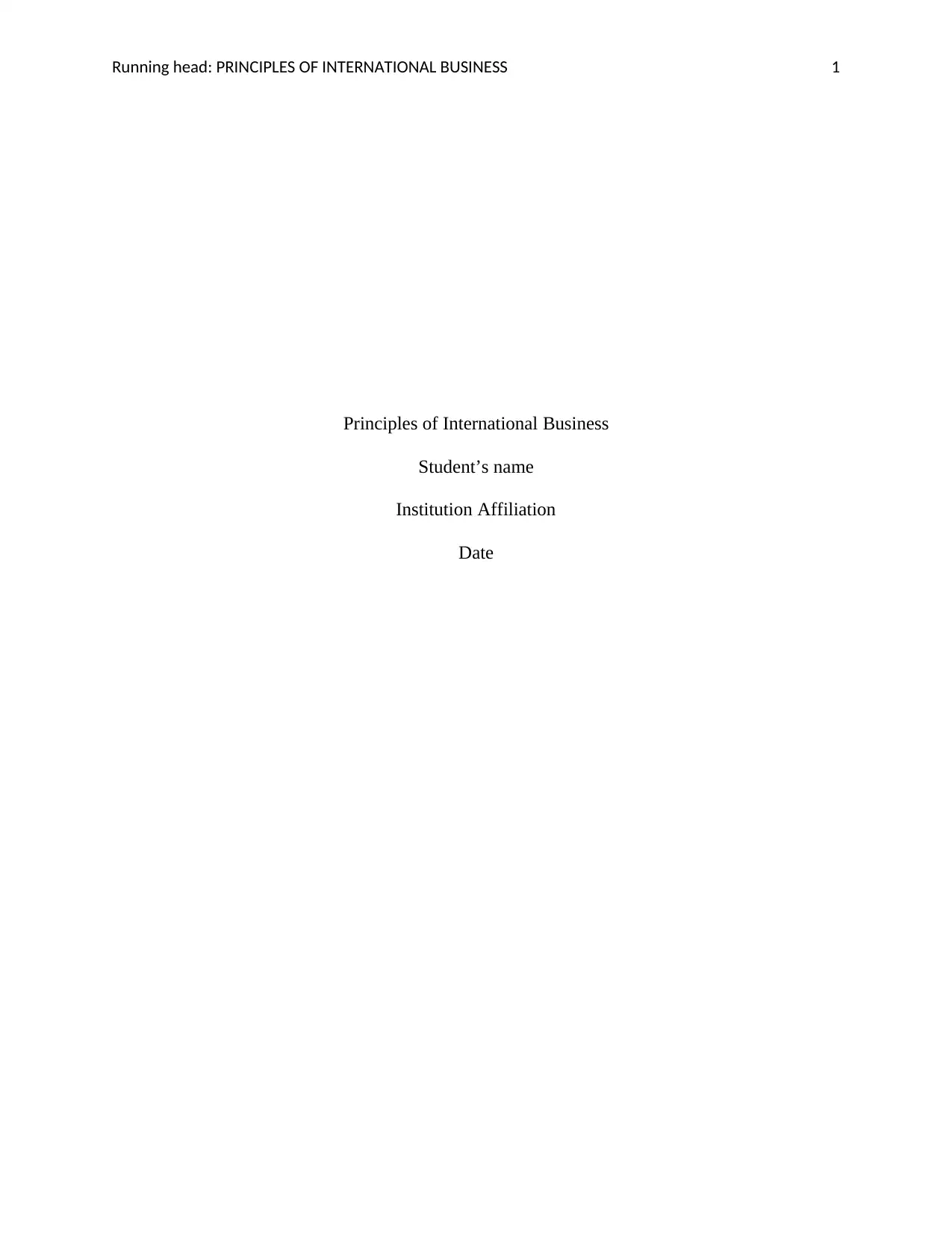
Running head: PRINCIPLES OF INTERNATIONAL BUSINESS 1
Principles of International Business
Student’s name
Institution Affiliation
Date
Principles of International Business
Student’s name
Institution Affiliation
Date
Paraphrase This Document
Need a fresh take? Get an instant paraphrase of this document with our AI Paraphraser
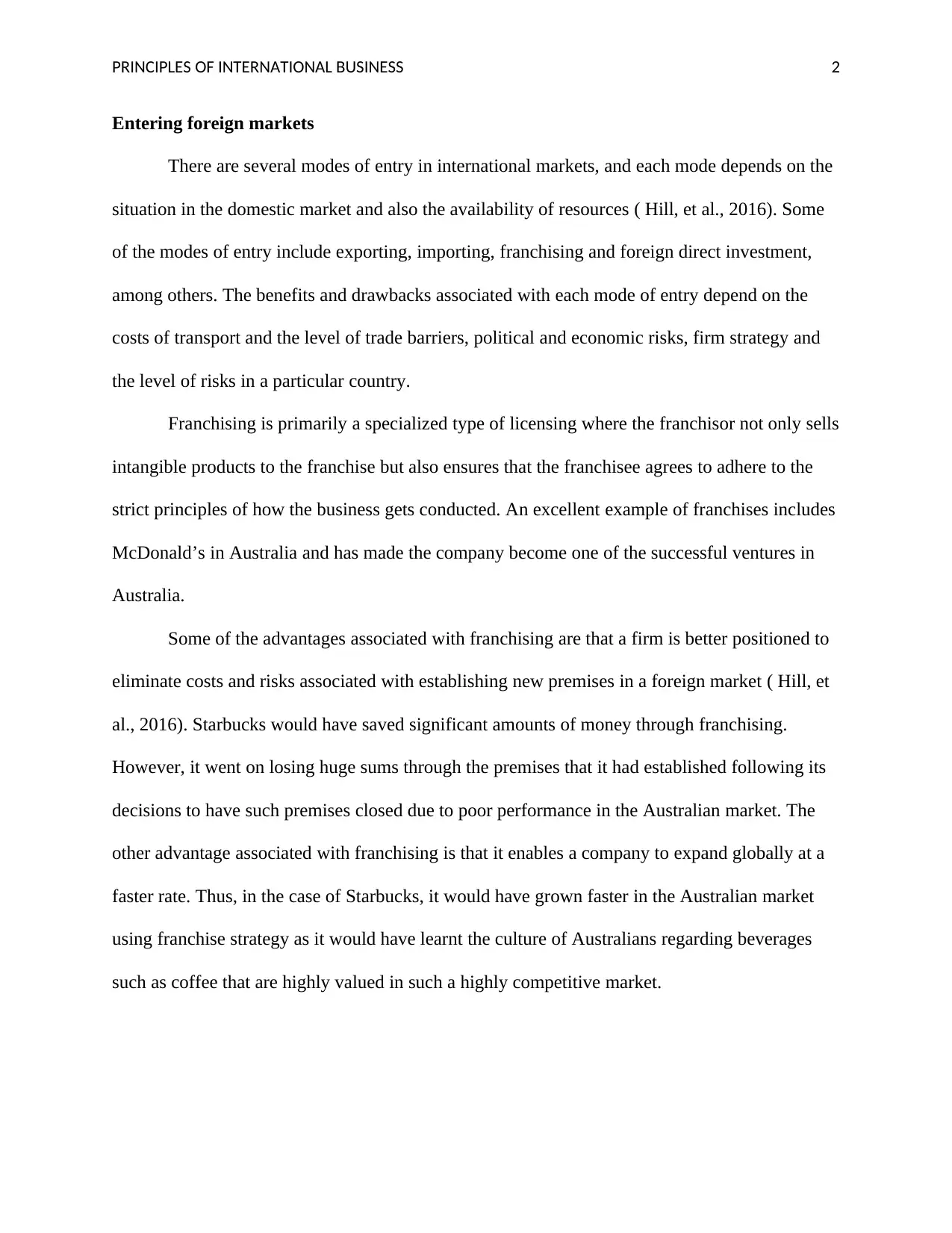
PRINCIPLES OF INTERNATIONAL BUSINESS 2
Entering foreign markets
There are several modes of entry in international markets, and each mode depends on the
situation in the domestic market and also the availability of resources ( Hill, et al., 2016). Some
of the modes of entry include exporting, importing, franchising and foreign direct investment,
among others. The benefits and drawbacks associated with each mode of entry depend on the
costs of transport and the level of trade barriers, political and economic risks, firm strategy and
the level of risks in a particular country.
Franchising is primarily a specialized type of licensing where the franchisor not only sells
intangible products to the franchise but also ensures that the franchisee agrees to adhere to the
strict principles of how the business gets conducted. An excellent example of franchises includes
McDonald’s in Australia and has made the company become one of the successful ventures in
Australia.
Some of the advantages associated with franchising are that a firm is better positioned to
eliminate costs and risks associated with establishing new premises in a foreign market ( Hill, et
al., 2016). Starbucks would have saved significant amounts of money through franchising.
However, it went on losing huge sums through the premises that it had established following its
decisions to have such premises closed due to poor performance in the Australian market. The
other advantage associated with franchising is that it enables a company to expand globally at a
faster rate. Thus, in the case of Starbucks, it would have grown faster in the Australian market
using franchise strategy as it would have learnt the culture of Australians regarding beverages
such as coffee that are highly valued in such a highly competitive market.
Entering foreign markets
There are several modes of entry in international markets, and each mode depends on the
situation in the domestic market and also the availability of resources ( Hill, et al., 2016). Some
of the modes of entry include exporting, importing, franchising and foreign direct investment,
among others. The benefits and drawbacks associated with each mode of entry depend on the
costs of transport and the level of trade barriers, political and economic risks, firm strategy and
the level of risks in a particular country.
Franchising is primarily a specialized type of licensing where the franchisor not only sells
intangible products to the franchise but also ensures that the franchisee agrees to adhere to the
strict principles of how the business gets conducted. An excellent example of franchises includes
McDonald’s in Australia and has made the company become one of the successful ventures in
Australia.
Some of the advantages associated with franchising are that a firm is better positioned to
eliminate costs and risks associated with establishing new premises in a foreign market ( Hill, et
al., 2016). Starbucks would have saved significant amounts of money through franchising.
However, it went on losing huge sums through the premises that it had established following its
decisions to have such premises closed due to poor performance in the Australian market. The
other advantage associated with franchising is that it enables a company to expand globally at a
faster rate. Thus, in the case of Starbucks, it would have grown faster in the Australian market
using franchise strategy as it would have learnt the culture of Australians regarding beverages
such as coffee that are highly valued in such a highly competitive market.
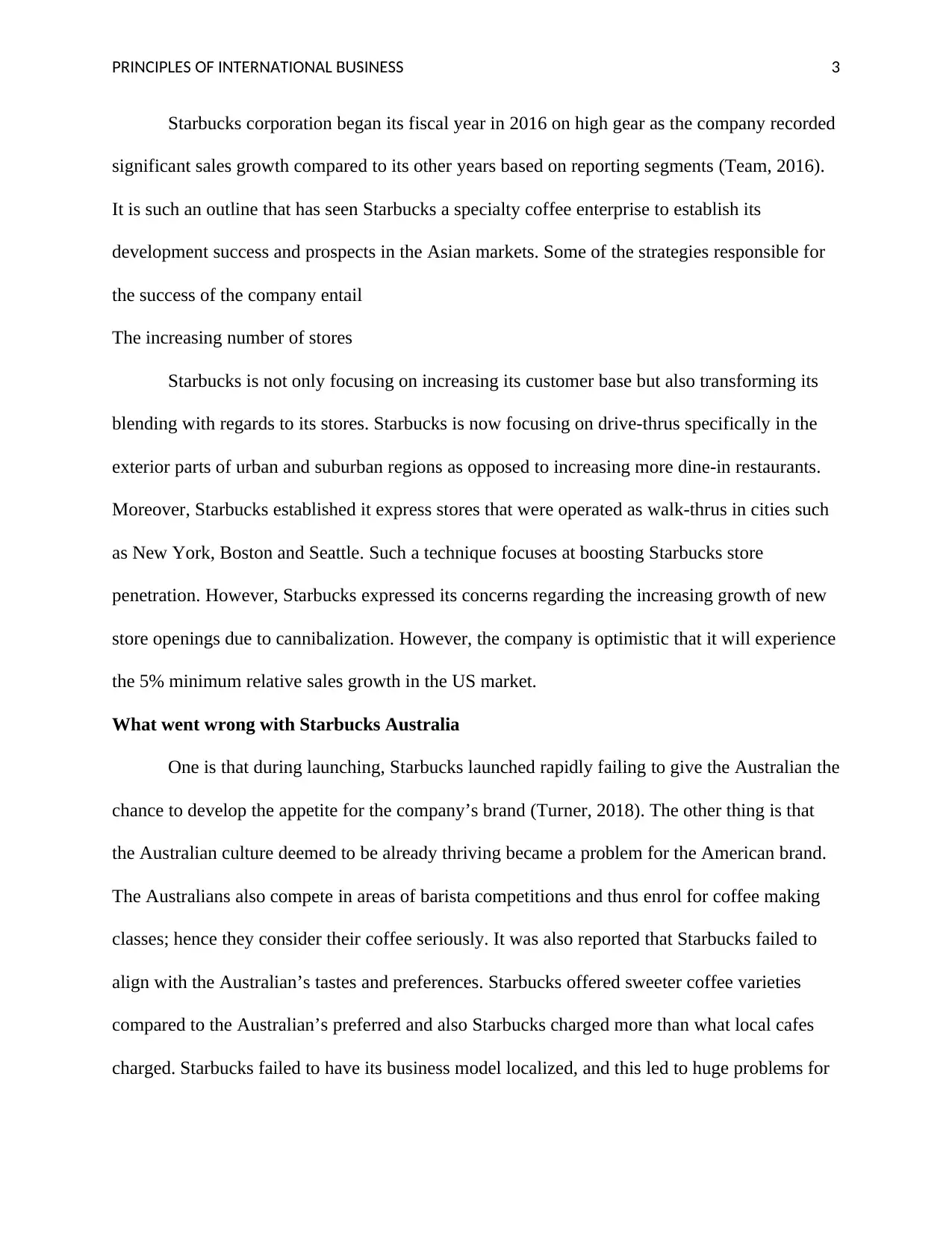
PRINCIPLES OF INTERNATIONAL BUSINESS 3
Starbucks corporation began its fiscal year in 2016 on high gear as the company recorded
significant sales growth compared to its other years based on reporting segments (Team, 2016).
It is such an outline that has seen Starbucks a specialty coffee enterprise to establish its
development success and prospects in the Asian markets. Some of the strategies responsible for
the success of the company entail
The increasing number of stores
Starbucks is not only focusing on increasing its customer base but also transforming its
blending with regards to its stores. Starbucks is now focusing on drive-thrus specifically in the
exterior parts of urban and suburban regions as opposed to increasing more dine-in restaurants.
Moreover, Starbucks established it express stores that were operated as walk-thrus in cities such
as New York, Boston and Seattle. Such a technique focuses at boosting Starbucks store
penetration. However, Starbucks expressed its concerns regarding the increasing growth of new
store openings due to cannibalization. However, the company is optimistic that it will experience
the 5% minimum relative sales growth in the US market.
What went wrong with Starbucks Australia
One is that during launching, Starbucks launched rapidly failing to give the Australian the
chance to develop the appetite for the company’s brand (Turner, 2018). The other thing is that
the Australian culture deemed to be already thriving became a problem for the American brand.
The Australians also compete in areas of barista competitions and thus enrol for coffee making
classes; hence they consider their coffee seriously. It was also reported that Starbucks failed to
align with the Australian’s tastes and preferences. Starbucks offered sweeter coffee varieties
compared to the Australian’s preferred and also Starbucks charged more than what local cafes
charged. Starbucks failed to have its business model localized, and this led to huge problems for
Starbucks corporation began its fiscal year in 2016 on high gear as the company recorded
significant sales growth compared to its other years based on reporting segments (Team, 2016).
It is such an outline that has seen Starbucks a specialty coffee enterprise to establish its
development success and prospects in the Asian markets. Some of the strategies responsible for
the success of the company entail
The increasing number of stores
Starbucks is not only focusing on increasing its customer base but also transforming its
blending with regards to its stores. Starbucks is now focusing on drive-thrus specifically in the
exterior parts of urban and suburban regions as opposed to increasing more dine-in restaurants.
Moreover, Starbucks established it express stores that were operated as walk-thrus in cities such
as New York, Boston and Seattle. Such a technique focuses at boosting Starbucks store
penetration. However, Starbucks expressed its concerns regarding the increasing growth of new
store openings due to cannibalization. However, the company is optimistic that it will experience
the 5% minimum relative sales growth in the US market.
What went wrong with Starbucks Australia
One is that during launching, Starbucks launched rapidly failing to give the Australian the
chance to develop the appetite for the company’s brand (Turner, 2018). The other thing is that
the Australian culture deemed to be already thriving became a problem for the American brand.
The Australians also compete in areas of barista competitions and thus enrol for coffee making
classes; hence they consider their coffee seriously. It was also reported that Starbucks failed to
align with the Australian’s tastes and preferences. Starbucks offered sweeter coffee varieties
compared to the Australian’s preferred and also Starbucks charged more than what local cafes
charged. Starbucks failed to have its business model localized, and this led to huge problems for
⊘ This is a preview!⊘
Do you want full access?
Subscribe today to unlock all pages.

Trusted by 1+ million students worldwide
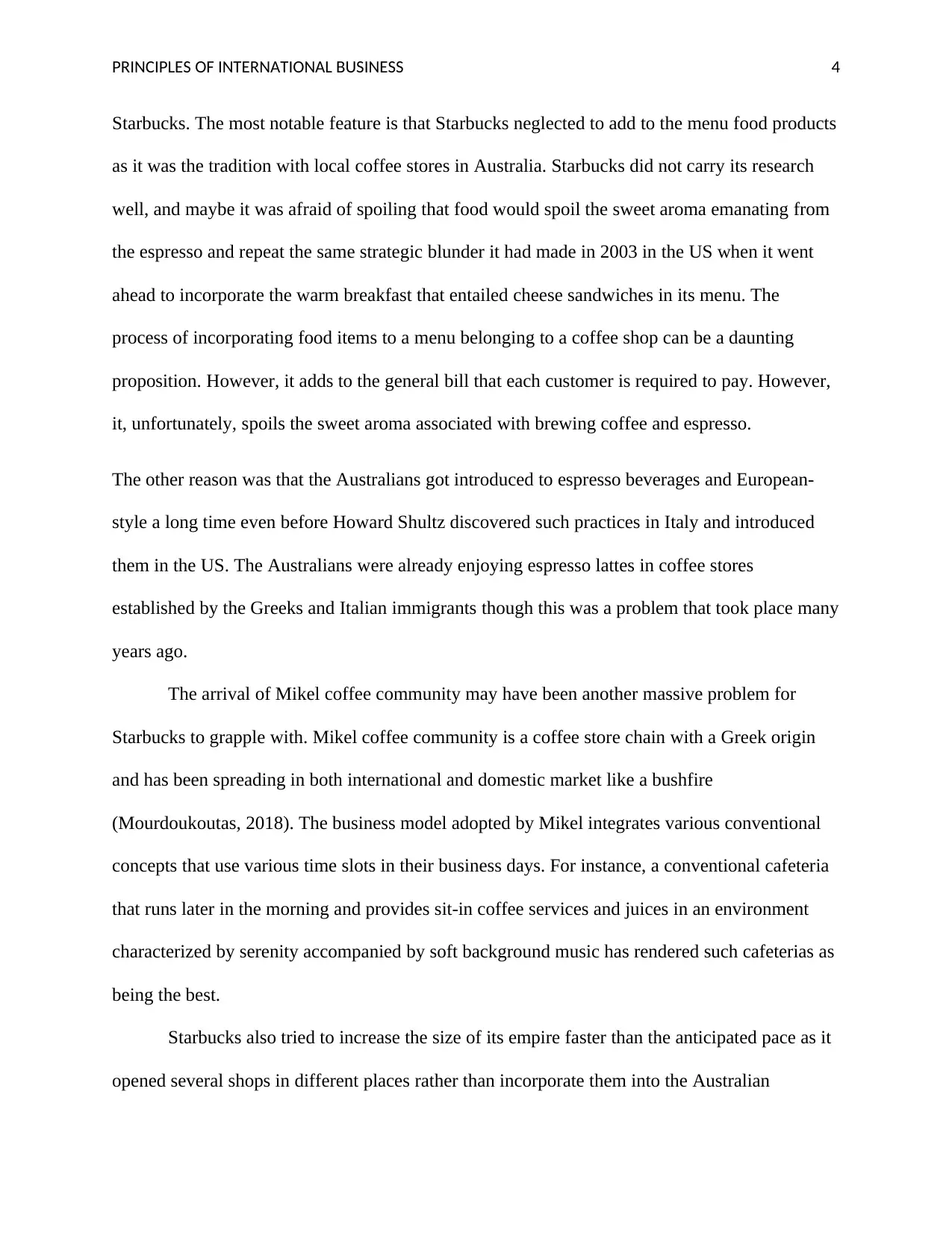
PRINCIPLES OF INTERNATIONAL BUSINESS 4
Starbucks. The most notable feature is that Starbucks neglected to add to the menu food products
as it was the tradition with local coffee stores in Australia. Starbucks did not carry its research
well, and maybe it was afraid of spoiling that food would spoil the sweet aroma emanating from
the espresso and repeat the same strategic blunder it had made in 2003 in the US when it went
ahead to incorporate the warm breakfast that entailed cheese sandwiches in its menu. The
process of incorporating food items to a menu belonging to a coffee shop can be a daunting
proposition. However, it adds to the general bill that each customer is required to pay. However,
it, unfortunately, spoils the sweet aroma associated with brewing coffee and espresso.
The other reason was that the Australians got introduced to espresso beverages and European-
style a long time even before Howard Shultz discovered such practices in Italy and introduced
them in the US. The Australians were already enjoying espresso lattes in coffee stores
established by the Greeks and Italian immigrants though this was a problem that took place many
years ago.
The arrival of Mikel coffee community may have been another massive problem for
Starbucks to grapple with. Mikel coffee community is a coffee store chain with a Greek origin
and has been spreading in both international and domestic market like a bushfire
(Mourdoukoutas, 2018). The business model adopted by Mikel integrates various conventional
concepts that use various time slots in their business days. For instance, a conventional cafeteria
that runs later in the morning and provides sit-in coffee services and juices in an environment
characterized by serenity accompanied by soft background music has rendered such cafeterias as
being the best.
Starbucks also tried to increase the size of its empire faster than the anticipated pace as it
opened several shops in different places rather than incorporate them into the Australian
Starbucks. The most notable feature is that Starbucks neglected to add to the menu food products
as it was the tradition with local coffee stores in Australia. Starbucks did not carry its research
well, and maybe it was afraid of spoiling that food would spoil the sweet aroma emanating from
the espresso and repeat the same strategic blunder it had made in 2003 in the US when it went
ahead to incorporate the warm breakfast that entailed cheese sandwiches in its menu. The
process of incorporating food items to a menu belonging to a coffee shop can be a daunting
proposition. However, it adds to the general bill that each customer is required to pay. However,
it, unfortunately, spoils the sweet aroma associated with brewing coffee and espresso.
The other reason was that the Australians got introduced to espresso beverages and European-
style a long time even before Howard Shultz discovered such practices in Italy and introduced
them in the US. The Australians were already enjoying espresso lattes in coffee stores
established by the Greeks and Italian immigrants though this was a problem that took place many
years ago.
The arrival of Mikel coffee community may have been another massive problem for
Starbucks to grapple with. Mikel coffee community is a coffee store chain with a Greek origin
and has been spreading in both international and domestic market like a bushfire
(Mourdoukoutas, 2018). The business model adopted by Mikel integrates various conventional
concepts that use various time slots in their business days. For instance, a conventional cafeteria
that runs later in the morning and provides sit-in coffee services and juices in an environment
characterized by serenity accompanied by soft background music has rendered such cafeterias as
being the best.
Starbucks also tried to increase the size of its empire faster than the anticipated pace as it
opened several shops in different places rather than incorporate them into the Australian
Paraphrase This Document
Need a fresh take? Get an instant paraphrase of this document with our AI Paraphraser
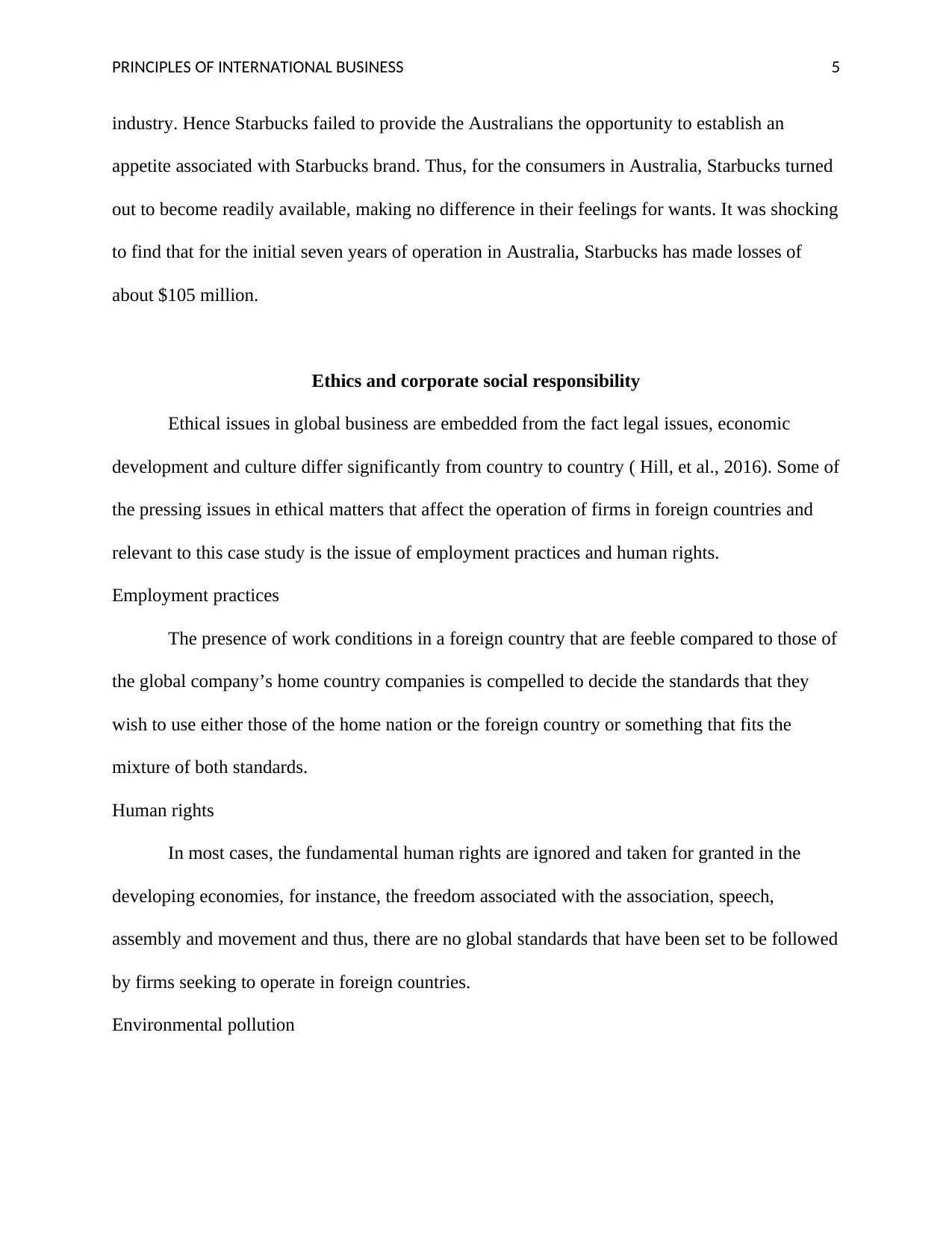
PRINCIPLES OF INTERNATIONAL BUSINESS 5
industry. Hence Starbucks failed to provide the Australians the opportunity to establish an
appetite associated with Starbucks brand. Thus, for the consumers in Australia, Starbucks turned
out to become readily available, making no difference in their feelings for wants. It was shocking
to find that for the initial seven years of operation in Australia, Starbucks has made losses of
about $105 million.
Ethics and corporate social responsibility
Ethical issues in global business are embedded from the fact legal issues, economic
development and culture differ significantly from country to country ( Hill, et al., 2016). Some of
the pressing issues in ethical matters that affect the operation of firms in foreign countries and
relevant to this case study is the issue of employment practices and human rights.
Employment practices
The presence of work conditions in a foreign country that are feeble compared to those of
the global company’s home country companies is compelled to decide the standards that they
wish to use either those of the home nation or the foreign country or something that fits the
mixture of both standards.
Human rights
In most cases, the fundamental human rights are ignored and taken for granted in the
developing economies, for instance, the freedom associated with the association, speech,
assembly and movement and thus, there are no global standards that have been set to be followed
by firms seeking to operate in foreign countries.
Environmental pollution
industry. Hence Starbucks failed to provide the Australians the opportunity to establish an
appetite associated with Starbucks brand. Thus, for the consumers in Australia, Starbucks turned
out to become readily available, making no difference in their feelings for wants. It was shocking
to find that for the initial seven years of operation in Australia, Starbucks has made losses of
about $105 million.
Ethics and corporate social responsibility
Ethical issues in global business are embedded from the fact legal issues, economic
development and culture differ significantly from country to country ( Hill, et al., 2016). Some of
the pressing issues in ethical matters that affect the operation of firms in foreign countries and
relevant to this case study is the issue of employment practices and human rights.
Employment practices
The presence of work conditions in a foreign country that are feeble compared to those of
the global company’s home country companies is compelled to decide the standards that they
wish to use either those of the home nation or the foreign country or something that fits the
mixture of both standards.
Human rights
In most cases, the fundamental human rights are ignored and taken for granted in the
developing economies, for instance, the freedom associated with the association, speech,
assembly and movement and thus, there are no global standards that have been set to be followed
by firms seeking to operate in foreign countries.
Environmental pollution
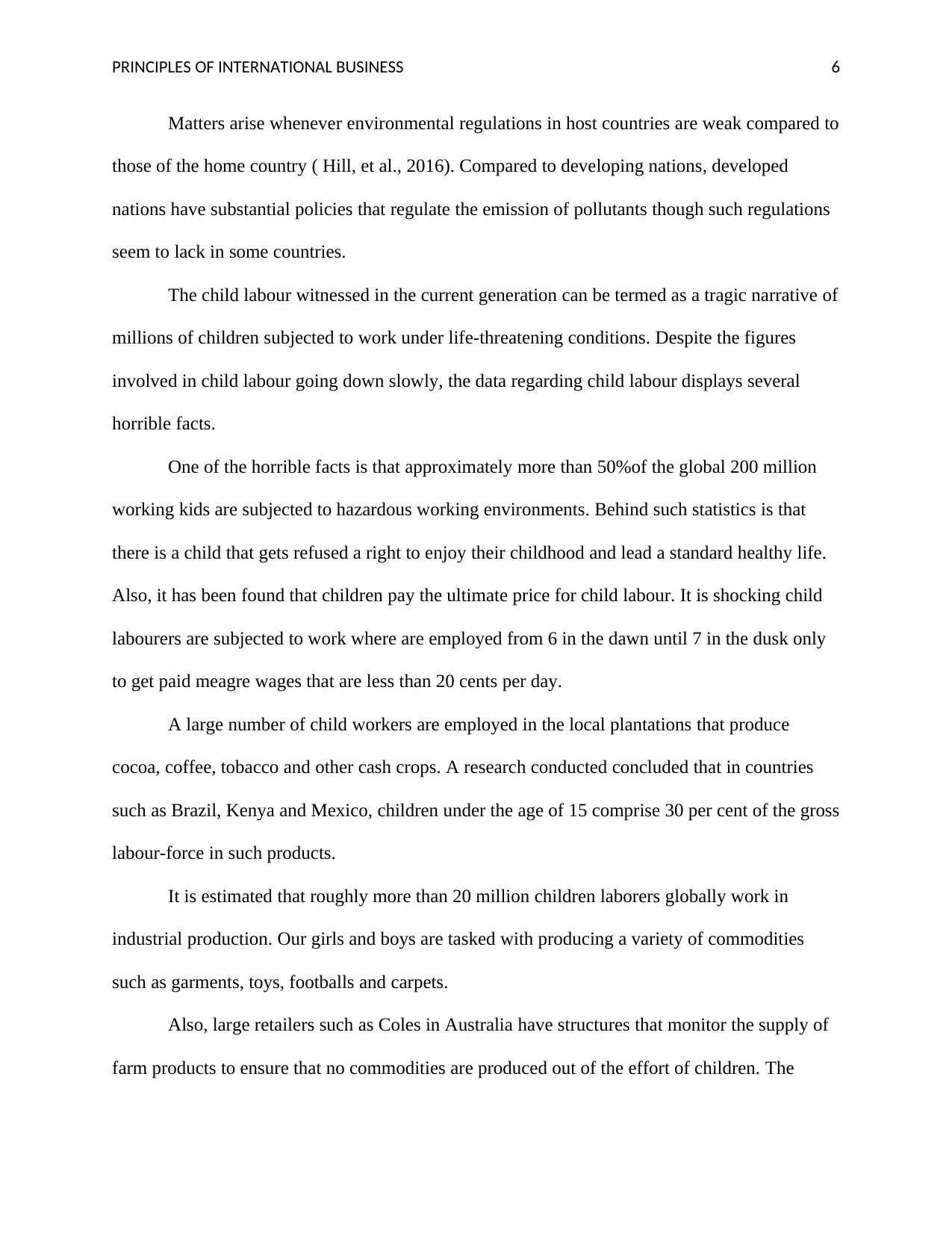
PRINCIPLES OF INTERNATIONAL BUSINESS 6
Matters arise whenever environmental regulations in host countries are weak compared to
those of the home country ( Hill, et al., 2016). Compared to developing nations, developed
nations have substantial policies that regulate the emission of pollutants though such regulations
seem to lack in some countries.
The child labour witnessed in the current generation can be termed as a tragic narrative of
millions of children subjected to work under life-threatening conditions. Despite the figures
involved in child labour going down slowly, the data regarding child labour displays several
horrible facts.
One of the horrible facts is that approximately more than 50%of the global 200 million
working kids are subjected to hazardous working environments. Behind such statistics is that
there is a child that gets refused a right to enjoy their childhood and lead a standard healthy life.
Also, it has been found that children pay the ultimate price for child labour. It is shocking child
labourers are subjected to work where are employed from 6 in the dawn until 7 in the dusk only
to get paid meagre wages that are less than 20 cents per day.
A large number of child workers are employed in the local plantations that produce
cocoa, coffee, tobacco and other cash crops. A research conducted concluded that in countries
such as Brazil, Kenya and Mexico, children under the age of 15 comprise 30 per cent of the gross
labour-force in such products.
It is estimated that roughly more than 20 million children laborers globally work in
industrial production. Our girls and boys are tasked with producing a variety of commodities
such as garments, toys, footballs and carpets.
Also, large retailers such as Coles in Australia have structures that monitor the supply of
farm products to ensure that no commodities are produced out of the effort of children. The
Matters arise whenever environmental regulations in host countries are weak compared to
those of the home country ( Hill, et al., 2016). Compared to developing nations, developed
nations have substantial policies that regulate the emission of pollutants though such regulations
seem to lack in some countries.
The child labour witnessed in the current generation can be termed as a tragic narrative of
millions of children subjected to work under life-threatening conditions. Despite the figures
involved in child labour going down slowly, the data regarding child labour displays several
horrible facts.
One of the horrible facts is that approximately more than 50%of the global 200 million
working kids are subjected to hazardous working environments. Behind such statistics is that
there is a child that gets refused a right to enjoy their childhood and lead a standard healthy life.
Also, it has been found that children pay the ultimate price for child labour. It is shocking child
labourers are subjected to work where are employed from 6 in the dawn until 7 in the dusk only
to get paid meagre wages that are less than 20 cents per day.
A large number of child workers are employed in the local plantations that produce
cocoa, coffee, tobacco and other cash crops. A research conducted concluded that in countries
such as Brazil, Kenya and Mexico, children under the age of 15 comprise 30 per cent of the gross
labour-force in such products.
It is estimated that roughly more than 20 million children laborers globally work in
industrial production. Our girls and boys are tasked with producing a variety of commodities
such as garments, toys, footballs and carpets.
Also, large retailers such as Coles in Australia have structures that monitor the supply of
farm products to ensure that no commodities are produced out of the effort of children. The
⊘ This is a preview!⊘
Do you want full access?
Subscribe today to unlock all pages.

Trusted by 1+ million students worldwide
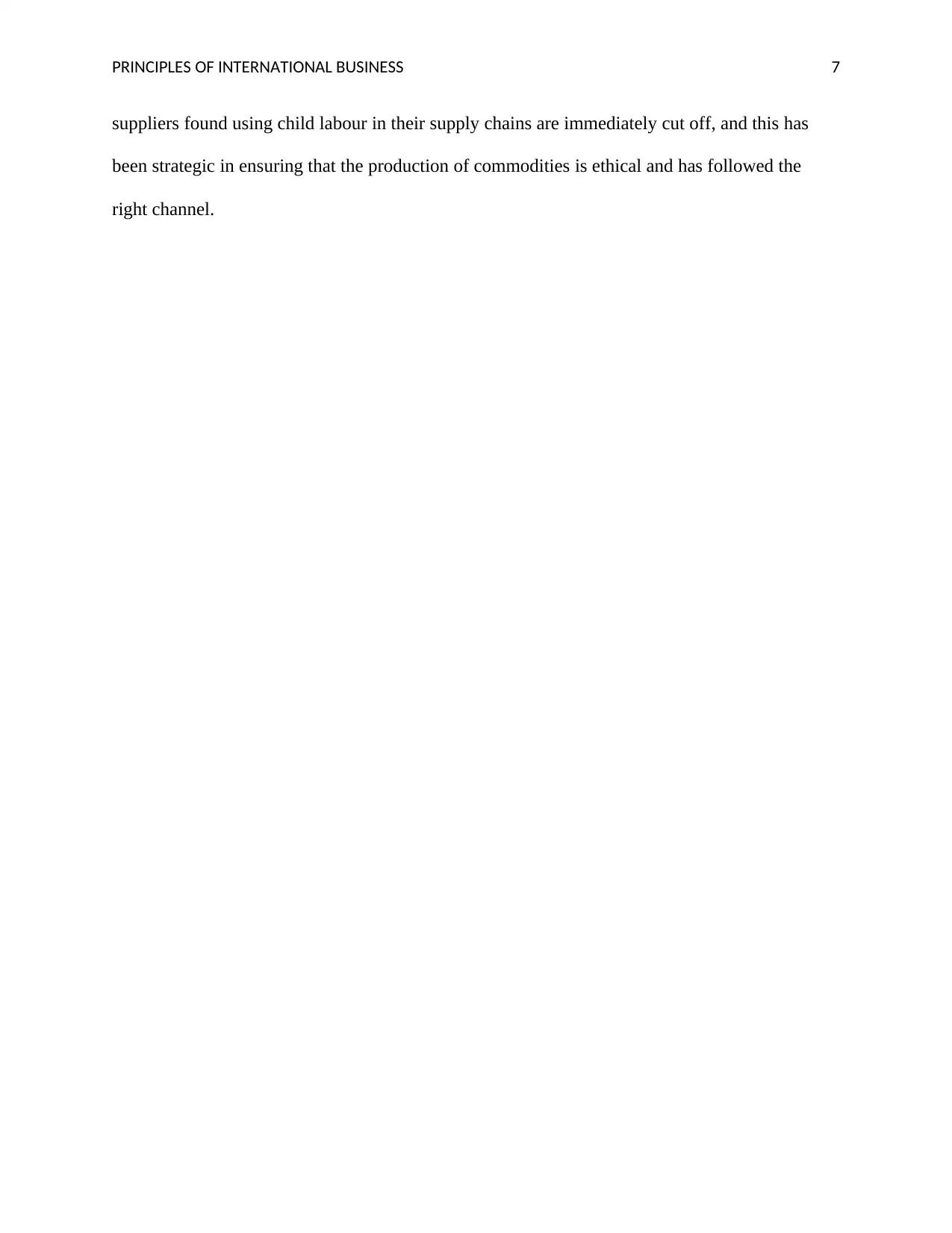
PRINCIPLES OF INTERNATIONAL BUSINESS 7
suppliers found using child labour in their supply chains are immediately cut off, and this has
been strategic in ensuring that the production of commodities is ethical and has followed the
right channel.
suppliers found using child labour in their supply chains are immediately cut off, and this has
been strategic in ensuring that the production of commodities is ethical and has followed the
right channel.
Paraphrase This Document
Need a fresh take? Get an instant paraphrase of this document with our AI Paraphraser
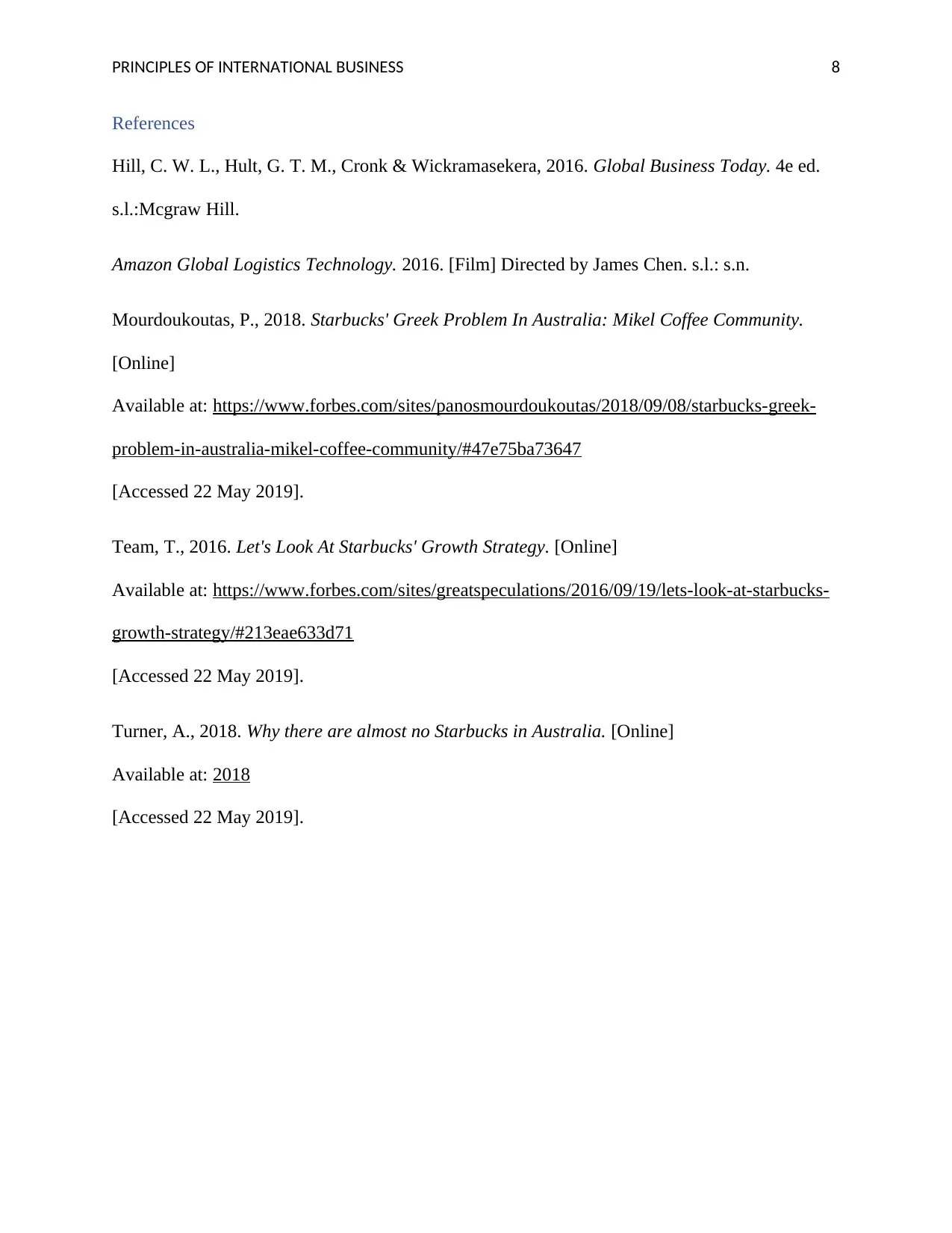
PRINCIPLES OF INTERNATIONAL BUSINESS 8
References
Hill, C. W. L., Hult, G. T. M., Cronk & Wickramasekera, 2016. Global Business Today. 4e ed.
s.l.:Mcgraw Hill.
Amazon Global Logistics Technology. 2016. [Film] Directed by James Chen. s.l.: s.n.
Mourdoukoutas, P., 2018. Starbucks' Greek Problem In Australia: Mikel Coffee Community.
[Online]
Available at: https://www.forbes.com/sites/panosmourdoukoutas/2018/09/08/starbucks-greek-
problem-in-australia-mikel-coffee-community/#47e75ba73647
[Accessed 22 May 2019].
Team, T., 2016. Let's Look At Starbucks' Growth Strategy. [Online]
Available at: https://www.forbes.com/sites/greatspeculations/2016/09/19/lets-look-at-starbucks-
growth-strategy/#213eae633d71
[Accessed 22 May 2019].
Turner, A., 2018. Why there are almost no Starbucks in Australia. [Online]
Available at: 2018
[Accessed 22 May 2019].
References
Hill, C. W. L., Hult, G. T. M., Cronk & Wickramasekera, 2016. Global Business Today. 4e ed.
s.l.:Mcgraw Hill.
Amazon Global Logistics Technology. 2016. [Film] Directed by James Chen. s.l.: s.n.
Mourdoukoutas, P., 2018. Starbucks' Greek Problem In Australia: Mikel Coffee Community.
[Online]
Available at: https://www.forbes.com/sites/panosmourdoukoutas/2018/09/08/starbucks-greek-
problem-in-australia-mikel-coffee-community/#47e75ba73647
[Accessed 22 May 2019].
Team, T., 2016. Let's Look At Starbucks' Growth Strategy. [Online]
Available at: https://www.forbes.com/sites/greatspeculations/2016/09/19/lets-look-at-starbucks-
growth-strategy/#213eae633d71
[Accessed 22 May 2019].
Turner, A., 2018. Why there are almost no Starbucks in Australia. [Online]
Available at: 2018
[Accessed 22 May 2019].
1 out of 8
Related Documents
Your All-in-One AI-Powered Toolkit for Academic Success.
+13062052269
info@desklib.com
Available 24*7 on WhatsApp / Email
![[object Object]](/_next/static/media/star-bottom.7253800d.svg)
Unlock your academic potential
Copyright © 2020–2025 A2Z Services. All Rights Reserved. Developed and managed by ZUCOL.





